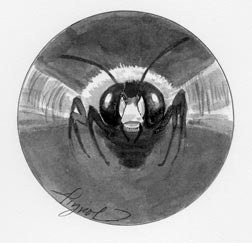
At first I thought that the bee was attacking me. As I dashed out of our garage, the bee suddenly appeared and hovered before my face in a seeming challenge. It looked like a bumble bee with a white face. After a few days of this, I realized that every time I walked from the garage to the house, the bee was there to greet me.
I quickly found out that this is common behavior of male carpenter bees as they patrol their small territories looking for intruders or mates. There’s no reason to be alarmed; males don’t sting. Only the dark-faced females can muster a sting, and usually only if handled. Male territories encompass about 60 feet around the nest site or food-plant area, and they will chase any interloper that comes near – birds, flying insects, people, and even, reportedly, the occasional airplane high in the sky.
There are over 275 species of native bees in our region, but there’s only one carpenter bee, the eastern carpenter bee (Xylocopa virginica), and they’re fairly easy to identify. At first blush they look like large bumble bees, but if you look more closely you’ll notice that they have shiny, black, and hairless abdomens. Peer even closer and you’ll see massive and sharp appendages, called galea, hanging down from the mouth. These are used to chew their way through wood, giving them their name.
Carpenter bees don’t eat wood. They chew through it, creating tunnels for nesting and resting in dead trees or branches, logs, or unfinished wood on structures. They prefer softwoods like pine, fir, or cedar, which are easier to excavate. With their sharp galea, a female chews a round entrance hole about a half-inch in diameter. It can take her up to two days to chew across the wood grain. Once the tunnel is about as deep as the length of her body, she turns ninety degrees and excavates more quickly going with the grain. If she comes to a knot, she’ll tunnel around it. Some nests have two or more tunnels that parallel the main hall, each over a foot long. They can use the same nest site year after year, sometimes by adding a new tunnel or lengthening an existing one. One studied colony was used for 14 years.
Carpenter bees are so-called solitary bees. Unlike honey bees, there are no queens or workers, just individual males and females. Newly hatched females may live together in the nest with their mother during their first year, but after that each female will have its own nest and brood.
At the end of a tunnel, the female lays an egg on a loaf of pollen the size of a kidney bean. At just over a half inch, it’s one of the largest insect eggs in the world. The female chews the surrounding wood into a pulp to create a cardboard like partition that seals the egg within its own cell. Each tunnel can have up to eight cells. When they hatch, the grubs feed on the loaf of pollen.
Here’s what gets them in trouble. Carpenter bees can create nests in fences, outdoor furniture, and buildings. They select bare wood on roof eaves, fascia boards, porch ceilings, decks, railings, siding, and shutters. They will seldom bore into painted or varnished wood.
It takes years for carpenter bees to cause significant structural damage. You can minimize their damage by filling and sealing nest holes in the fall or winter with a small dowel or caulk and covering with fresh paint. Filling them in the spring or summer will just cause the female to make a new entrance hole. You can also provide alternative nesting sites in untreated cedar boards, their favorite wood.
Why not just eradicate them? Carpenter bees pollinate plants in 19 different families, from spring lupines to late-summer goldenrods. Like most bees, they enter the opening of a flower and reach in with their glossa, like a long tubular tongue, to suck nectar. They also gather pollen to carry away on their bristled-covered rear legs.
Carpenter bees are also cheaters. If the flower is too small or too long for them to reach with their relatively short glossa, they put their carpenter’s skill to work and simply cut a hole into the base of the flower for direct access to the nectar. Other bees will also sometimes feed at these nectar holes as well.
Over the last decade, carpenter bees have been moving farther and farther north. Keep watch for the hovering male signaling his territory around you.


Discussion *